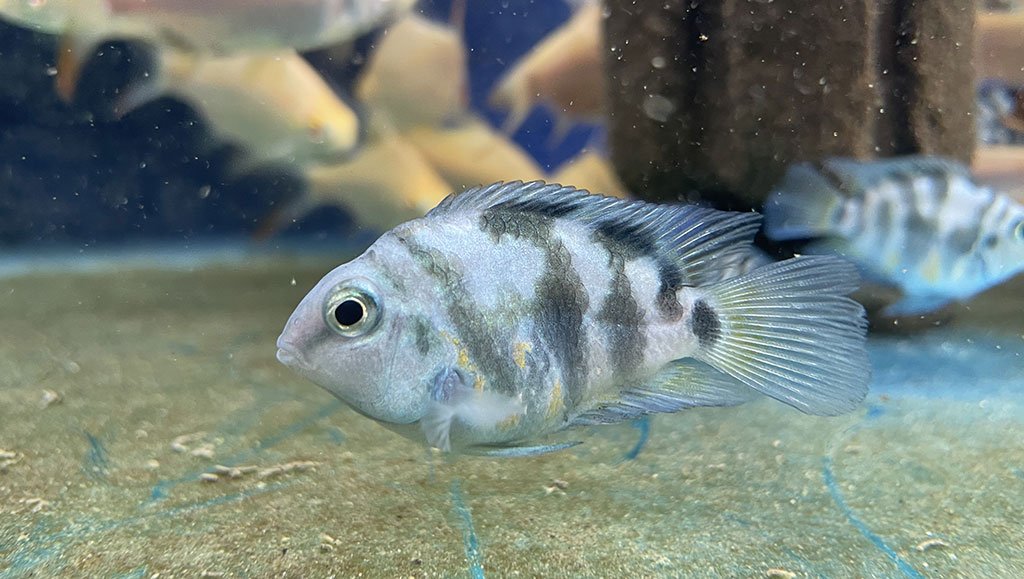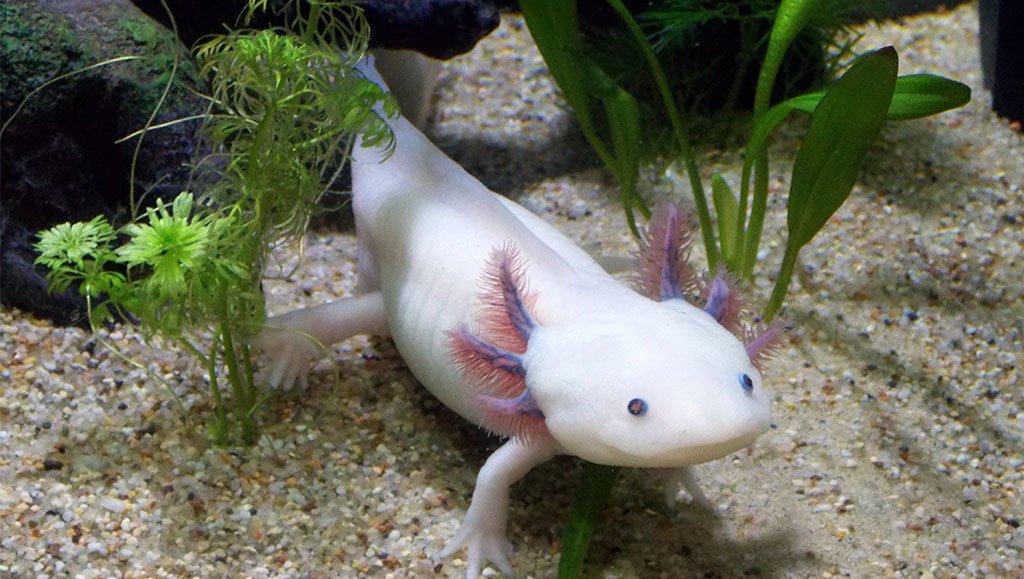Welcome, fellow axolotl enthusiasts! If you’re fascinated by these unique creatures, especially the mesmerizing GFP (Green Fluorescent Protein) axolotls, you’re in the right place!
These glowing wonders are not only a sight to behold under blacklight but also bring a whole new level of excitement and curiosity to our hobby.
Whether you’re a seasoned axolotl keeper or just beginning to explore the world of these charismatic amphibians, you’ll find that GFP axolotls offer a fascinating window into genetic expression and the wonders of nature.
I’m here to guide you through everything you need to know about caring for these amazing creatures, ensuring their health and happiness.
Together, we’ll explore their unique characteristics, the specifics of their care, and important health considerations, ensuring you’re fully equipped to provide the best for your fluorescent friends. Get ready to deep-dive into the glowing, wonderful world of GFP axolotls!
Characteristics of GFP Axolotls
One of the first things that come to mind when thinking about GFP axolotls is their fluorescent properties. But did you know that they also possess other unique characteristics?
GFP axolotls are a type of salamander, native to Mexico, where they were once abundant in lakes and canals. However, due to urbanization and pollution, they are now critically endangered in the wild.
Their name, axolotl, comes from the Aztec language and means “water monster.” And while they may look otherworldly with their external gills and lack of metamorphosis, they are entirely harmless to humans.
But back to their fluorescent properties – how do they glow? The GFP gene is naturally found in jellyfish, and scientists have been able to insert it into axolotls’ DNA, creating these dazzling creatures. This genetic modification does not harm the axolotls in any way and is purely for aesthetic purposes.
Care and Maintenance
Now that we’ve covered some of the unique characteristics of GFP axolotls, let’s delve into what it takes to care for them properly.
Tank Setup Requirements
Size and Type of Tank
To start off, the ideal home for your GFP axolotl would be a spacious aquarium that allows them plenty of room to move and explore. A single adult axolotl thrives in a tank that’s at least 20 gallons, but if you’re planning to keep more than one, you’ll need to go bigger – add an extra 10 gallons for each additional axolotl. Glass tanks are typically preferred due to their durability and clear viewing, enabling you to marvel at your glowing companions in all their splendor.
Substrate and Decorations
Choosing the right substrate is crucial for the well-being of your GFP axolotls. Fine sand is often recommended as it minimizes the risk of impaction issues, which can occur if larger particles are ingested. When it comes to decorations, aim for a naturalistic setup with plenty of hiding spots such as caves, plants (live or silk), and smooth rocks. This not only makes your tank aesthetically pleasing but also replicates their natural habitat, making your axolotls feel secure.
Water Parameters
For your GFP axolotls to be healthy, it is necessary to maintain the water’s properties at the proper values. It is crucial to routinely monitor the ammonia levels, nitrite, and nitrate; the optimal values for ammonia and nitrite are 0 ppm and for nitrate, they should be less than 20 ppm. Consistency is key to preventing stress and health issues, so keep those water parameters stable.
Ideal pH Levels
The ideal pH level for your GFP axolotl’s tank should be between 6.5 and 7.5. This slightly acidic to neutral range is crucial for their well-being, as extremes on either end can cause stress and health problems. Routine checks with a reliable pH test kit will help you maintain these levels and ensure your axolotls thrive.
Temperature Range
GFP axolotls are best kept in cooler water, in the optimal temperature range of 16°C to 20°C, or 60°F to 68°F. Temperatures above this range can lead to stress and health issues, including fungal infections and decreased oxygen levels in the water. Consider using a tank cooler or placing the aquarium in a cooler part of your home to maintain these optimal conditions.
Filtration Systems
A gentle yet effective filtration system is vital for keeping the water clean and oxygen-rich, without creating strong currents that can stress your axolotls. Sponge filters or external canister filters with adjustable flow rates are excellent choices. Whatever system you choose, make sure it’s rated for more than the size of your tank to ensure efficient filtration, keeping the environment safe and clean for your fluorescent friends.
Feeding Habits and Diet
Feeding your GFP axolotls the right diet is not just about nourishment; it’s about enriching their lives and ensuring they glow with health inside and out! Here, we’ll explore the types of food, feeding schedule, and how to manage portion control to keep your axolotls in top shape.
Types of Food
GFP Axolotls are not picky eaters, but they do require a balanced diet to thrive. Live food, such as earthworms, bloodworms, and small feeder fish, can stimulate natural hunting behaviors and enrich their environment. Frozen food offers convenience and variety, including frozen bloodworms and brine shrimp; just be sure to thaw them properly before feeding. Pellets formulated specifically for axolotls can also be a part of their diet, providing essential nutrients and making feeding time a breeze. A mixture of live, frozen, and pellet foods ensures your GFP axolotls receive a broad spectrum of nutrients, keeping them healthy and vivacious.
Feeding Schedule
Consistency is key! Feeding your GFP axolotls on a regular schedule not only makes their life more predictable but also aids in optimal digestion and nutrient absorption. Juveniles, with their rapidly growing bodies, require daily feeding. Adults, however, thrive on being fed every other day. Adhering to a regular feeding schedule also allows you to monitor their appetite, an important indicator of health.
Portion Control
Portion control is crucial since excessive feeding can have negative health effects and underfeeding might hinder growth. Generally speaking, you should feed your axolotl food that is about the size of its head each time. This amount usually ensures they’re getting just enough nutrition without overeating. Observing your axolotl during and after feeding times can help you adjust portions as needed, ensuring they’re always at their best health.
Incorporating a variety of food types, sticking to a consistent feeding schedule, and managing portion sizes are foundational steps in nurturing your GFP axolotls. Watching them glow with vitality, you’ll know that your care and attention are paying off, illuminating the path to a long and luminous life for these extraordinary creatures.
Health Considerations for GFP Axolotls
Like all living things, GFP axolotls are susceptible to health issues. And while proper care and maintenance can greatly reduce the likelihood of illness, It’s critical to maintain vigilance and take quick action to resolve any possible issues. Here are some common health concerns to watch out for, along with tips on how to prevent them.
Common Health Issues
GFP axolotls, with their delicate constitutions, can face various health challenges, including fungal and bacterial infections, and parasitic infestations. Being well-informed about these issues is the first step towards ensuring your axolotl companions stay healthy and vibrant.
Fungal and Bacterial Infections
Fungal infections often present as white, cottony growths on the axolotl’s body, while bacterial infections may cause redness, swelling, or sores. Both can stem from poor water quality or stress, emphasizing the necessity for pristine tank conditions.
Parasitic Infestations
Parasites, visible as tiny, moving dots on the axolotl or in its feces, can severely impact their health. Regular observation and maintaining a clean habitat are paramount to prevent these unwelcome guests.
Signs of Stress and Disease
Stress and illness in GFP axolotls can manifest through behavioral changes or physical symptoms. A loss of appetite, lethargy, or abnormal buoyancy are red flags every caretaker should be vigilant about.
Behavioral Changes
Any sudden change in behavior, such as increased hiding or decreased activity, might indicate that your axolotl is not feeling well and requires immediate attention.
Physical Symptoms
Physical signs of distress can include skin lesions, unusual feces, or excessive mucus production. These symptoms demand prompt investigation and corrective measures.
Preventative Measures
Preventive care is integral to keeping your GFP axolotls in peak condition and minimizing the risk of illness.
Regular Water Changes
Regular water changes can drastically lower the danger of infections and keep your axolotls’ environment in a balanced state. To do this, remove roughly 20% of the tank’s water each week and replace it with new, dechlorinated water.
Quarantine Procedures for New Additions
Quarantining new plants, animals, or decorations before introducing them into your main tank can help prevent the spread of parasites or diseases. A quarantine period of 2-4 weeks is advisable, ensuring any potential threat is neutralized.
Staying educated on the common health issues GFP axolotls may face, recognizing the early signs of stress or illness, and taking proactive, preventive steps can greatly enhance the well-being of these mesmerizing creatures. Your diligent care and nurturing environment pave the way for a thriving, vibrant life for your GFP axolotls.
Environmental Enrichment for GFP Axolotls
As conscientious caretakers, we all know how important it is to provide our GFP axolotls with a comfortable and clean habitat. But did you know that environmental enrichment can also greatly impact their overall health and well-being? In this section, we’ll explore some simple yet effective ways to keep your axolotls engaged and stimulated in their tank.
Creating a dynamic and engaging habitat for GFP axolotls not only mirrors their natural environment but also promotes physical and mental wellness. Here are some key pointers to enhance their living space with enrichment and care:
Providing Hiding Places and Shelter
Offering various hiding spaces, like caves and tunnels, simulates the axolotl’s natural habitat, providing them with a sense of security. These shelters can be fashioned from safe, non-toxic materials like ceramic or natural stone, ensuring your axolotls have a private retreat whenever they feel the need.
Use of Plants and Decorations
Incorporating plants and decorations not only beautifies the tank but also contributes to the well-being of your axolotls. Live plants, in particular, help maintain water quality, while decorations can add complexity to the environment, encouraging exploration and exercise.
Importance of Visual Barriers
Establishing visual barriers within the tank with plants or decorations can help reduce stress, especially in tanks housing multiple axolotls. Such barriers provide privacy and minimize confrontations, ensuring a harmonious living space.
Stimulating Activities
Engaging your GFP axolotls in stimulating activities can promote their natural behaviors. This could be as simple as gently rearranging the tank’s layout to encourage exploration or introducing novel items for them to investigate, keeping their environment fresh and intriguing.
Introduction of Live Prey
Releasing live prey, such as bloodworms or small feeder fish, into the tank can trigger the axolotl’s natural hunting instincts, providing both nutritional and mental enrichment. It’s a thrilling spectacle that mirrors the wild aspects of their lifestyle.
Interactive Toys and Gadgets
Although not traditional pets, axolotls can interact with specially designed aquatic toys and gadgets. Floating balls, safe, movable objects, or even gently flowing currents can offer curiosity-driven activities, making their daily life more vibrant.
Tank Maintenance and Cleaning Schedule
It is essential to maintain the axolotl’s habitat on a regular basis. By creating a regular cleaning programme that includes complete tank cleanings every month and partial water changes every week, you can stop dangerous germs from growing and keep your pets’ habitat stable and healthy.
Algae Control Methods
Algae can quickly overtake a tank if not managed properly. Employing natural methods like introducing algae-eating snails or shrimps, alongside regular tank cleanings, can help keep algae growth in check without resorting to harsh chemicals.
Putting these practices into action not only nurtures the physical health of your GFP axolotls but also supports their psychological well-being. It’s a joyous endeavor to see them thrive in an enriched, well-maintained habitat, displaying their unique behaviors and glowing beauty to the fullest. Your commitment and love for these fascinating creatures truly make all the difference.
Frequently Asked Questions
Q: How often should I feed my GFP axolotls?
A: It is recommended to feed adult axolotls once a day, while juvenile axolotls can be fed twice daily. Offer them as much food as they can consume in 5-10 minutes.
Q: Can I keep multiple GFP axolotls together in one tank?
A: Yes, axolotls are social creatures and can thrive in a group. However, it is important to ensure that the tank is properly sized and has enough hiding spaces and visual barriers for each axolotl.
Q: How do I know if my GFP axolotl is stressed or sick?
A: Some physical symptoms of stress or illness in axolotls include abnormal swimming behavior, loss of appetite, or changes in skin color. It is important to monitor your axolotls closely and seek a veterinarian’s advice if you notice any concerning signs.
Q: How can I control the temperature in my axolotl’s tank?
A: Axolotls prefer a temperature of 60 to 68°F. To keep the temperature in your aquarium at the right level, you can use a submersible aquarium heater. Additionally, It’s imperative to maintain the tank away from heat sources and bright sunshine to prevent dramatic temperature fluctuations.
Q: How many types of axolotl are there ?
A: It depends on many factors, so there is no exact answer for this question but you can read about 17 types of axolotl form our guide.
Q: Can I handle my GFP axolotls?
A: While axolotls are generally docile and can be handled, it is important to minimize handling as much as possible. Their delicate skin can easily get irritated or damaged, and they also have the tendency to accidentally swallow objects while being handled. If you must handle your axolotls, make sure to do so with clean, wet hands and for short periods of time.
Q: How can I prevent my tank from becoming smelly?
A: Regular tank maintenance, including partial water changes and cleaning of decorations, can help keep the tank clean and odor-free. It is also important to avoid overfeeding, as excess food can lead to bacterial growth and foul odors.
Reference Links
- GFP Axolotl Care and Tank Setup Guide
- Tank Cleaning 101: How to Clean a Fish Tank
- Algae Control in Aquariums
- How to Set Up a Safe and Comfortable Home for Your Axolotl
- Axolotl: The Fascinating Mexican Water Dragon
- Enrichment for Captive Axolotls
- Axolotls as Pets: A Complete Care Guide
My Thoughts
Keeping GFP axolotls as pets is a rewarding and unique experience. These captivating creatures require proper care and maintenance to thrive, but with the right knowledge and dedication, they can make wonderful additions to any home. You can ensure that your axolotls are happy and healthy and provide them with a stimulating habitat by putting these suggestions and techniques into practice. Never forget to consult a specialist if you have any worries regarding the health of your axolotls, and enjoy the wonder of sharing your life with these incredible amphibians. Happy axolotl-keeping! 🐾🌱




